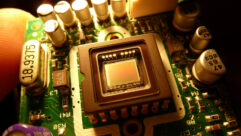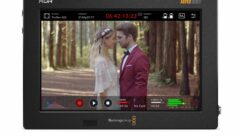The Next Step: Familiarize yourself with DVD-Video, one of the more recentcontenders in the video format arena.
May 1, 1998 12:00 PM,
Mark Waldrep
After almost 20 years as a recording and mastering engineer, I now findmyself routinely writing or speaking about new technologies that aredriving the convergence of A-V media delivery, not only for consumers, butalso for corporate and industrial users as well. The popular press hascompletely ignored the profundity of the DVD-Video format, and it is myhope that I can shed some much needed light on the true potential of thisemerging technology.
First of all, DVD does not stand for digital video disc. In fact, accordingto the latest information I’ve heard, it doesn’t really stand for anything,not even digital versatile disc (complications with internationalcopyrights and other legal issues). It’s acceptable, at least for now, tothink of it as digital video disc because most people that have DVDmachines have them in their living rooms connected to their television orhome entertainment center. They are buying the machines and movie softwaretitles to play back with surround audio tracks. The DVD advertising thatyou may have seen on television has marketed the product as a replacementfor your VHS, differing from VHS only by DVD’s delivery of video and audiowith inspiring quality. The hardware and software giants behind DVDtechnology are presenting only half the story, as they have thus faromitted the interactive component of the format and its tremendous power toprovide instant nonlinear access to audio and video media. A more accurateanalogy would be a comparison of DVD playback with CD playback. Bothformats use the same form factor; both play in a self-contained,consumer-friendly component type box, and both provide random access to thedigital content encoded on them. Basically, a DVD player is functionallythe same as a CD player with the addition of a video jack on the back andsome extra buttons on the IR controller. If any machine is likely to bereplaced, it’s going to be your worn-out CD player because a DVD machinewill play audio CDs as well as DVDs.
Development history Hollywood approached the large multinational consumerelectronics firms in the early 1990s with the idea of developing ahigh-quality motion picture delivery disc format. Laserdiscs had developedinto a small but profitable niche market, important to videophiles,corporate A-V departments and educators but without widespread consumeracceptance. What was needed was a compact disc-sized movie format toreplace VHS tape. Two camps emerged with competing proposals forhigh-density CDs. The Toshiba/Time Warner folks had Super Disc, and theSony/Philips team presented Multimedia CD. Both formats were essentiallyhigh-density CDs with important physical and data differences. The exactnature of the proposed formats is not really important in the scope of thisarticle. What is important, however, is the results obtained when in 1995,the companies agreed to combine the best aspects of both approaches into asingle worldwide standard. The DVD-Video specification took shape over thefollowing year and was completed in the fall of 1996. First-generationhardware and a trickle of software titles began to emerge in Japan duringthe Christmas season with introduction to the U.S. market occurring inMarch of 1997. It was, in fact, four titles produced and released on theMarch 19, 1997 (five days ahead of Warner Bros.) by AIX Entertainment thatstarted the DVD ball rolling. Upon the first-year anniversary of theformat, it was estimated that 400,000 DVD players had been sold and thatalmost 800 titles were currently available. Sales of DVD have exceeded allother new consumer formats (including CDs), making it the most successfulnew technology introduction in the history of consumer electronics. Thecurrent buzz surrounding DVD has reached a frenzied level-companies rangingfrom graphics design firms and authoring/compression housesto replicationplants are swamped with movie title work.
The physical specifications A DVD disc is the same physical size as acompact disc, about 4.75 inches (121 mm) across and 0.12 mm thick. Thedifference is that the DVD disc is made up of two separately manufacturedhalves that are bonded together after being molded in the manufacturingprocess, allowing access to data on both sides. Additionally, each side canbe composed of two individual data layers, effectively doubling theirstorage capacity. Each layer of each side has six to seven times the memorycapacity of a compact disc. The four types of DVD discs reflect the totaldata capacity available on each. DVD-5 discs, (single layer, single side)store 4.7 GB; DVD-9 discs (single side, dual layer) hold 8.4 GB; DVD-10discs (dual sides, single layer) have 9.4 GB, and DVD-17 discs contain 16.8GB. (See Figure 1.)
The software features described in the 1.0 specification include manyinteresting capabilities unique to the format. The consortium of companiesresponsible for the design has developed a solution that is far moreflexible and farsighted than could have been imagined. A DVD disc can do alot more than play back a linear MPEG-2 video stream with better qualityaudio and video; this is a format that was custom-made for informationkiosks, museum and institutional installations, and interactive videoproducts.
DVD delivers a continuous stream of digital data comprised of multipleaudio tracks, video, sub-pictures (8-bit graphics overlays) andnavigational information. All of the components are multiplexed together ina rigid arrangement so that the DVD players can easily decipher and decodethem. Specialized tools, both hardware and software, are required toprepare each of the media components prior to this mixing process.
The source video is compressed using MPEG-2 encoding; the same encodingthat is delivered through direct satellite transmissions only limited inits bandwidth to about 8 to 9 Mbps (megabits per second). The quality ofthe encoded video is dependent on several things-the quality of the sourcetape, the hardware and software used to do the encoding and the skill ofthe compressionist-but can result in video that is far better than VHS andeven surpasses Laserdiscs. By comparison, MPEG-1, the video-encoding schemeused in CDi and VCDs (video compact discs), is capable of VHS quality andrequires multiple discs to store a standard-length movie. DVD toolmakershave paraded out a competing series of expensive hardware encoders over thepast year, machines that averaged about $100,000 each. Thankfully, theprices have fallen recently, and quality and ease of use have gone up.MPEG-2 seems within reach of corporate A-V departments and will undoubtedlymigrate down even further over the next six to 12 months. A good qualityencoder can by acquired for less than $30,000, but don’t forget that youstill will need an expensive digital VTR as input.
Multiple video streams DVD offers one interesting capability that has notbeen used extensively in conventional software titles available on themarket so far (except on those titles being produced by the adultindustry), the ability to switch between multiple video streamssimultaneously. This feature is commonly referred to as multiple cameraangles and is accessible through a special button on the remote controller.Up to nine independent videos can be selected while the audio continues toplay seamlessly. The idea is to have multiple cameras running at the timeof the initial shooting to provide end users with the ability to chosetheir preferred point of view. There is no requirement that the videomaterial be multiple camera angles of the same subject, so there are manycreative possibilities in the format for creative use by moviemakers in thefuture. The use of the multiple camera angle feature of DVD requiresadditional spaceon the disc and therefore limits the length of the program.A 133-minute single stream of video compressed at an average of 4.5 Mbpswill fill a 4.7 GB single-sided DVD.If you want to run a parallel videotrack throughout the entire program, the length will have to be reduced byabout half to accommodate the second video stream.
There are two methods of encoding video-variable bit rate (VBR) andconstant bit rate (CBR). The cost of the hardware, the time it takes toencode a segment of video and the quality of the results varies with thetype of encoding used. CBR, at its maximum of around 8 Mbps, can achieveoutstanding video quality but limits the length of the program to under anhour, less than that required for the average Hollywood film. It also canbe accomplished in less time because the encoding algorithm is able to doits work in a single pass through the video rather than the multipletechniques required by the VBR method. VBR automatically allocatesadditional bandwidth (i.e. memory) to the sections of the film that havethe most action and lowers the bit-rate when the content is less active.Most of the expensive encoders have the capability to do both formats.
After an interesting year of behind-the-scenes political wrangling, theaudio requirements for DVD-Video exist in only two formats: Dolby Digitaland PCM (pulse code modulation). PCM is the same uncompressed format thatit used on compact discs and is favored by the audiophile community. Dolbyuses its own AC-3 compression algorithm to provide very reasonable audioquality for either stereo tracks or the much-promoted 5.1 surround standardin which “5.1” refers to the use of five discrete, full bandwidth audiochannels allocated to three front speakers (left, center, right) and tworear speakers (left and right surround) and one low frequency channel sentto a subwoofer. DTS is also available as a higher quality alternative to5.1 Dolby Digital but requires an additional specialized decoder. DolbyDigital, on the other hand, managed to become the worldwide standard foraudio compression on DVD discs and is included on higher end players andA-V receivers. The sound benefits of surround are tremendous and worth theinvestment in additional channels of amplification and surround speakers.
Just as there are multiple video streams available on a DVD-Video disc,there are up to eight audio tracks selectable through the use of the IRremote. The audio button on the remote control cycles through the audiotracks sequentially or the use of onscreen programming can set the desiredaudio channel. Hollywood studio releases are currently using the additionalaudio capability for foreign language versions or directors’ commentarytracks. Each of the audio tracks can be presented in either Dolby Digital(stereo or 5.1) or PCM. If the user doesn’t have a Dolby Digital capableplayback unit, the 5.1 channels are automatically mixed internally tostereo or the DVD design can offer a separate track in specific stereo mixon an alternate audio track.
The future of high-end audio The world of high-end audio is experimentingwith the use of higher sampling rates and word sizes to improve the qualityof audio delivery to audio-conscious consumers. The DVD-Video specificationincludes sampling rates of 48 to 96 kHz and word sizes up to 24 bits. Thesehigh-resolution audio specs require large amount of bandwidth and should beused only when the highest audio quality is required. The DVD consortiumhas an emerging DVD-Audio specification that is nearing final draft status,but the impact will be minimal until well into 1999, if it becomesimportant at all.
The use of sub-pictures provides the DVD-Video format with the ability todo foreign language subtitling, up to 32 different languages are possibleaccessible via use of the remote controller. Information presented throughthe use of sub-pictures is not limited to text in foreign languages; anygraphic image can be displayed on the screen as long as it is limited tofour colors. This makes DVD-Video perfect for karaoke as well asinformational kiosks and dedicated education. As an example of DVD as ateaching tool, AIX Entertainment is currently working with Berklee Collegeof Music on an instructional guitar series of DVDs that will allow the userto display the chord symbols on the screen during lessons.
It’s the navigational prowess of the DVD-Video format that holds itsgreatest potential. Imagine being able to bring up a table of contents on agiven product and instantly jump to the desired piece of video within ahalf a second. Elements within a video stream can be programmed to play asa continuous program or broken into individual parts, each with a separatetitle card of chapter access point. There is a new Pioneer industrial DVDplayer (the VP-7200) that includes a bar-code reader and software allowingaccess to thousands of pieces of video with the swipe of the light pen overa printed bar code. DVD-Video is the consumer-friendly, living roomalternative to the computer-based CD-ROM world of multimedia, thanks to thebuilt-in navigational system of titles and chapters. It is true that DVDsare much more expensive and difficult to create than CD-ROMs, but they arealso more reliable and much easier to use.
DVD-Video has arrived and seems destined to establish itself as the opticaldisc technology beyond the compact disc. The DVD set top machines areinexpensive, ranging from just under $400 for an inexpensive Toshiba toabout $1,000 for the full-featured Pioneer industrial player or theconsumer Sony deck. Also making an appearance on the market are portableplayers such as the L10 from Panasonic, which comes complete with 16:9 LCDscreen, a sort of Discman for DVD-Video. The format will benefit from thevast number of multimedia computer systems that include built-in DVD-ROMdrives, expected to exceed 10 million units in 1998. Any production thatwill play in a DVD-Video player will play in one of these computer systemswithout any additional hardware or software.
Innovative DVD producers are targeting the corporate presentation and CBT(computer based training) markets, an area that will undoubtedly embracethe ease of use and high quality of DVDs. There are numerous applicationsthat can be imagined and created if we think outside the narrowness of thedefinition promoted by the popular press. DVD-Video is a highlyinteractive, user-friendly, random access A-V delivery medium requiring nopost installation technical support, something computers will never be ableto claim.










